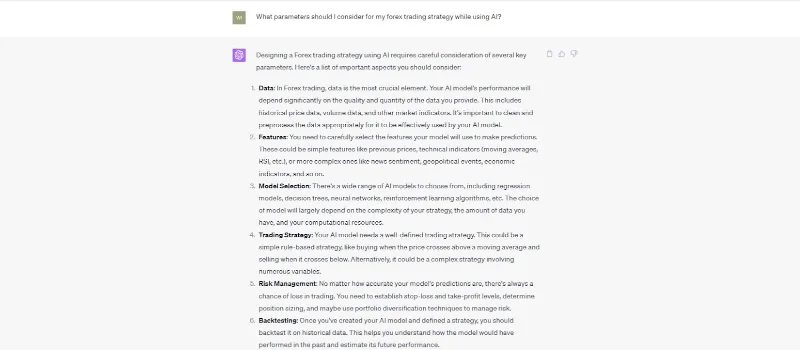Are you curious about the impact of artificial intelligence (AI) in the ever-evolving world of AI forex trading? It’s reshaping the landscape, unlocking incredible potential for market analysis, risk management, and automated trades. But does it truly deliver results?
Join us as we dive into the power of AI in forex trading, exploring its applications and how you can leverage this technology to enhance your trading strategies amidst market complexities.
The Power of AI in Forex Trading
Have you considered the significant advancements brought by the integration of AI in forex trading? This development offers numerous benefits to traders. With AI-powered strategies, you can make rapid and precise automated trading decisions while effectively managing risks and maximizing profits.
Explore with us the three key areas in which AI excels within the forex trading industry. These areas include enhanced market analysis, improved risk management, and automated trading execution.
Enhanced Market Analysis
AI algorithms possess the remarkable capability to swiftly process vast volumes of market data. In doing so, they uncover valuable insights on trends and patterns that may prove elusive for human analysts. This advanced market analysis empowers traders by enabling them to identify emerging opportunities and make well-informed decisions.
Furthermore, AI-based market analysis offers more efficient and cost-effective methods to identify and capitalize on opportunities. By automating trading decisions through AI algorithms, manual intervention is reduced, enabling traders to focus on strategic tasks.
The cost of using AI for ChatGPT trading, for example, is also a very compelling factor for people to utilize this new technology.
Improved Risk Management
AI can play a crucial role for traders like you in managing risk. It helps by identifying potential pitfalls and suggesting adjustments to your trading strategies. By providing the ability to recognize and mitigate risks, AI-driven risk management empowers you to make more informed decisions and reduce your overall exposure to risk.
Additionally, AI algorithms serve as a valuable tool in detecting fraudulent or suspicious activity within the forex market. This crucial function helps safeguard traders from potential scams and manipulative practices.
By providing an extra layer of protection, AI significantly enhances the overall value and reliability of forex trading.
Automated Trading Execution
AI empowers you to automate trade execution, enabling you to seize opportunities swiftly and efficiently. By employing AI trading bots, you can effortlessly devise automated strategies and…
- Formulate ‘if-then’ strategies
- Convert them into coded algorithm strategies
- Integrate them with platforms trading platforms, web and mobile apps.
By choosing to execute trades automatically, traders can:
- Free up time to focus on strategic decision-making and other aspects of their trading
- Ensure more accurate and reliable trading decisions through the use of AI algorithms
- Minimize costly mistakes
Developing an AI-Based Forex Trading Strategy

Now that you have an understanding of the immense potential of AI in forex trading, let’s delve into the process of developing an AI-based forex trading strategy. To create a successful strategy powered by AI, it is essential to follow a few key steps.
1. First, you need to carefully select the most suitable AI technology for your specific needs.
2. Next, define the trading parameters that align with your investment goals and risk tolerance.
3. Finally, rigorously backtest and optimize.
Selecting the Right AI Technology
If you want to fully utilize artificial intelligence in forex trading, it is essential for you to select the appropriate AI technology.
You, as a forex trader, can benefit from employing machine learning, natural language processing, and computer vision solutions that cater to your specific trading requirements.
Machine learning algorithms possess the ability to analyze vast amounts of historical data. By leveraging this data, they can accurately forecast future market trends. Additionally, natural language processing algorithms can be employed to examine news articles and social media, aiding in the understanding of market sentiment.
Conversely, computer vision algorithms can be harnessed to scrutinize charts and graphs, facilitating pattern identification.
To create tailored strategies that maximize the strengths of each AI technology, traders like yourself can carefully select the most suitable one.
Defining Trading Parameters
To guide AI in decision-making, it is crucial to establish trading parameters. These parameters encompass various aspects of a trade, including entry and exit points. Additionally, they involve risk management and trade management strategies.
Technical analysis tools such as trend lines, support and resistance levels, as well as chart patterns can aid in identifying the entry and exit points.
Risk management is a vital factor in trading parameters. Traders can effectively handle their risk and optimize their trading strategies by implementing various risk management techniques, such as setting stop-loss orders, diversifying investments, and utilizing leverage.
Backtesting and Refinement
To develop an AI-based forex trading strategy, one crucial step is backtesting. You evaluate the accuracy and potential performance of the strategy using historical data. This process allows you to gauge its effectiveness and make informed decisions.
- Measure the risks and returns of their strategies
- Identify any flaws or weaknesses in the strategy
- Optimize and refine the strategy before implementing it in the market
If you want to enhance your chances of success in the forex market, it’s essential for traders to conduct thorough backtesting.
By employing these powerful tools in backtesting, you can evaluate how your strategies would have performed in different market conditions. This valuable analysis enables you to refine and optimize your approaches, leading to smarter decisions based on past performance.
Ultimately, this translates into increased profitability for your trades.
Real-Life Examples of AI in Forex Trading
AI has already made a significant impact on forex trading. Real-life examples vividly demonstrate its effectiveness. In the following section, we will delve into three key applications of AI in forex trading: high-frequency trading, sentiment analysis, and pattern recognition.
Did you know that high-frequency trading is a type of algorithmic trading that employs artificial intelligence (AI) to make swift and informed decisions?
High-Frequency Trading (HFT)

Did you know that high-frequency trading (HFT) represents a prime illustration of AI’s potential in the world of forex trading? By employing powerful computers and AI algorithms, HFT efficiently executes numerous orders at remarkable speeds. This strategy capitalizes on even the tiniest market price fluctuations.
Although High-Frequency Trading (HFT) can be highly profitable, it is important to recognize the associated risks. These include relying on unpredictable algorithms and potential market manipulation. However, it is worth noting that when implemented correctly, HFT showcases the immense potential of artificial intelligence in forex trading.
Sentiment Analysis
Did you know that sentiment analysis is a remarkable application of artificial intelligence (AI) in forex trading? It showcases the immense capabilities of AI in analyzing market trends. By leveraging AI to analyze news articles and social media data, sentiment analysis can effectively gauge market sentiment and make predictions regarding potential market movements.
This technique provides valuable insights into customer sentiment and market trends. It helps businesses make more informed decisions regarding product development, marketing strategies, and customer service. Moreover, sentiment analysis showcases the immense potential of AI for forex traders.
Pattern Recognition
Do you want the power to predict future market trends? Pattern recognition, an AI application, is here to assist traders like you. By analyzing historical data, it identifies recurring patterns that can help you anticipate market movements. This approach not only recognizes trends but also pinpoints support and resistance levels and other patterns that can optimize your trading decisions.
You can minimize risk and enhance your trading performance by leveraging pattern recognition. This real-life example showcases how artificial intelligence in forex trading empowers traders to make more informed decisions.
Overcoming Challenges in AI Forex Trading

AI offers immense potential for forex trading, but along with its advantages come challenges that traders must navigate to fully harness its capabilities. In this section, we will delve into three pivotal challenges in AI forex trading: ensuring the quality and availability of data, adapting to evolving market conditions, and striking a balance between automation and human expertise.
To ensure successful AI forex trading, it is crucial to prioritize data quality and accessibility. Artificial intelligence algorithms heavily rely on accurate and available data.
Data Quality and Availability
Data quality and availability play vital roles in enabling AI algorithms to make precise predictions and informed decisions in forex trading. To ensure the accuracy, completeness, and timeliness of the data utilized by these algorithms is of utmost importance for generating reliable insights and minimizing potential errors.
In order to make timely decisions, it is essential to have access to up-to-date data. AI algorithms rely on current data for accurate predictions and informed decisions. By addressing these challenges, traders can fully leverage the potential of AI in forex trading.
Adapting to Market Changes
The forex market undergoes constant fluctuations, demanding AI algorithms to adapt and remain effective. By assimilating new information and adjusting strategies based on prevailing market conditions, these algorithms empower informative predictions and proficient trading decisions in the realm of forex markets.
Techniques such as high-frequency trading, sentiment analysis, and pattern recognition can help AI algorithms adapt to market changes. By employing these methods, traders can ensure their AI-driven strategies remain relevant and effective in the ever-changing forex market.
Balancing Automation and Human Expertise
To optimize processes and judgment, it is crucial to strike a balance between automation and human expertise in forex trading. AI can complement human decision-making without fully replacing it. Therefore, finding the right combination of leveraging technology and harnessing human cognition becomes vital.
Carefully evaluate the strengths of AI and the unique value humans bring. By striking the right balance between AI, automation, and human oversight, traders can optimize the advantages of AI-driven forex trading strategies while minimizing potential risks.
Summary
In conclusion, AI presents immense opportunities for forex trading. It offers advanced market analysis, improved risk management, and automated trade execution. Traders can leverage the power of AI by selecting suitable technology, defining trading parameters, and refining strategies through backtesting.
This enables them to make well-informed decisions and optimize their trading performance. While exploring the potential of AI in forex trading, it is crucial to strike a balance between automation and human expertise.
By doing so, we ensure that AI functions as a powerful tool rather than replacing human intuition and judgment.


